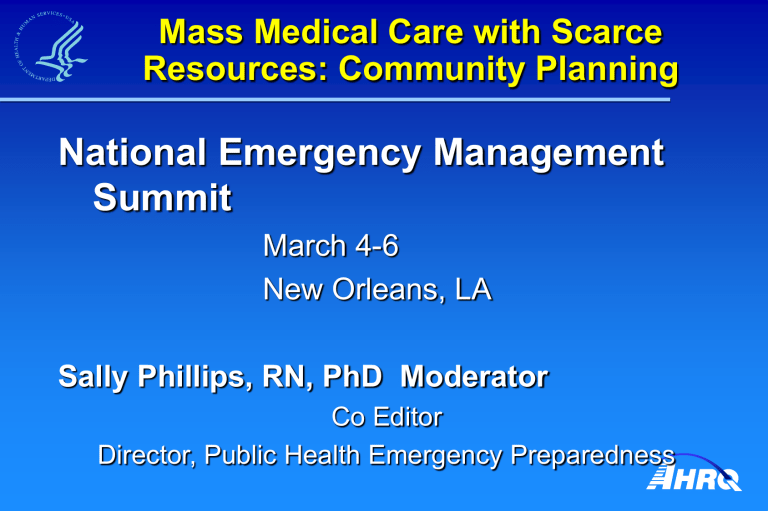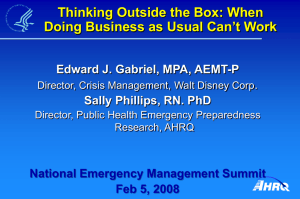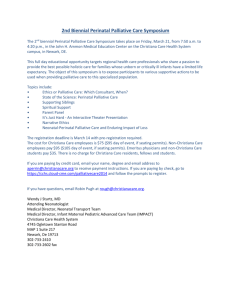AHRQ Master Slide Template

Mass Medical Care with Scarce
Resources: Community Planning
National Emergency Management
Summit
March 4-6
New Orleans, LA
Sally Phillips, RN, PhD Moderator
Co Editor
Director, Public Health Emergency Preparedness
Providing Mass Medical Care with Scarce
Resources: A Community Planning Guide
Collaboration between AHRQ and ASPR
Ethical Considerations in Community Disaster
Planning
Assessing the Legal Environment
Prehospital Care
Hospital/Acute Care
Alternative Care Sites
Palliative Care
Influenza Pandemic Case Study
Editors:
Sally J. Phillips- AHRQ
Ann Knebel- HHS/ASPR
–
–
–
Lead Authors:
–
–
Marc Roberts, PhD Harvard University
James C. Hodge, Jr.- Georgetown and Johns
Hopkins University
–
–
Edward J. Gabriel- Walt Disney Corp.
John L. Hick- Hennepin County Medical Center,
University of Minnesota
Stephen Cantrill- Denver Health Medical Center
Anne Wilkerson- RAND Corp
Marianne Matzo- University of Oklahoma
Ethical Principles
Greatest good for greatest number
– Utilitarian perspective important to consider
Other principles important to consider
– Respecting the norms and values of the community
– Respecting all human beings
– Determining what is right and fair
Ethical Principles
Ethical process requires
–
–
–
–
Openness
Explicit decisions
Transparent reporting
Political accountability
Difficult choices will have to be made; the better we plan the more ethically sound the choices will be
Legal Issues
Can the local community declare a disaster?
Advance planning and issue identification are essential, but not sufficient
Legal Triage – planners should partner with legal community for planning and during disasters
Prehospital Care
Edward Gabriel, M.P.A., AEMT-P
Edward Gabriel, Director of Crisis Management for Walt Disney Corporation; Past Deputy
Commissioner for Planning and Preparedness
NYC Office of Emergency Management
PREHOSPITAL CARE
The Main Issue For Planners
In the event of a Catastrophic MCE, the emergency medical services (EMS) systems will be called on to provide first-responder rescue, assessment, care, and transportation and access to the emergency medical health care system.
The bulk of EMS in this country is provided through a complex system of highly variable organizational structures.
RECOMMENDATIONS:
EMS PLANNERS
Plan and implement strategies to maximize to the extent possible:
Use and availability of EMS personnel
Transport capacity
Role of dispatch and Public Safety Answering
Points
RECOMMENDATIONS:
EMS PLANNERS
Mutual aid agreements or interstate compacts to:
Address licensure and indemnification matters regarding responders
Address memoranda of understandings
(MOUs) among public, volunteer, and private ambulance services
Coordinate response to potential MCEs
RECOMMENDATIONS:
EMS PLANNERS
Use natural opportunities to exercise disaster planning
Develop strategies to identify large numbers of young children who may be separated from parents
Develop strategies to identify and respond to vulnerable populations
RECOMMENDATIONS:
EMS PLANNERS
Develop partnerships with Federal,
State, and local stakeholders to clarify roles, resources, and responses to potential MCEs
Improve communication and coordination strategies and backup plans
Exercise, evaluate, modify, and refine
MCE plans
FORGING PARTNERSHIPS
AT ALL LEVELS
“Emergency management is really about building relationships, whether you are in the public or private sector.”
“And in building those relationships, it is important to remember not to tell , but to talk .”
Hospital Care
John L. Hick, M.D.
Emergency Physician
Hennepin County Medical Center
Chair, Metropolitan Hospital Compact
Hospital Care
Planning Assumptions
Overwhelming demand
Greatest good
Resources lacking
No temporary solution
Federal level may provide guidance
Operational implementation is
State/local
State emergency health powers
Provider liability protection
Coordinated Mass Casualty Care
Effective incident management critical
Fully integrated
– Conduct action planning cycles
– Anticipate resource needs
– Make timely requests and allocate
Coordinated Mass Casualty Care
Increased system capacity (surge capacity)
Decisionmaking process for resource allocation
– Shift from reactive to proactive strategies
– Administrative vs. clinical changes
Incremental changes to standard of care
Usual patient care provided
Low impact administration changes
Administrative Changes to usual care
Triage set up in lobby area
Significant reduction in documentation
Meals served by nonclinical staff
Nurse educators pulled to clinical duties
Disaster documentation forms used
Significant changes in nurse/patient ratios
Use of non-healthcare workers to provide basic patient cares (bathing, assistance, feeding)
Cancel most/all outpatient appointments and procedures
Need increasingly exceeds resources
Vital signs checked less regularly
Deny care to those presenting to ED with minor symptoms
Stable ventilator patients managed on step-down beds
Minimal lab and x-ray testing
Clinical Changes to usual care
Austere patient care provided
High-impact clinical changes
Re-allocate ventilators due to shortage
Significantly raise threshold for admission
(chest pain with normal
ECG goes home, etc.)
Use of non-healthcare workers to provide basic patient cares (bathing, assistance, feeding)
Allocate limited antivirals to select patients
State-level Responsibilities
Recognize resource shortfall
Request additional resources or
facilitate transfer of
patients/alternativ e care site
Provide supportive policy and decision tools
Provide liability relief
Manage the scarce resources in an equitable framework
Hospital Responsibilities
Plan for administrative adaptations (roles and responsibilities)
Optimize surge capacity planning
Practice incident management and work with regional stakeholders
Decisionmaking process for scarce resource situations
Scarce Clinical Resources
Process for planning vs. process for response
Response concept of operations:
– IMS recognizes situation
– Clinical care committee
– Triage plan
– Decision implementation
Clinical Care Committee
Multiple institutional stakeholders decide, based on resources and demand:
– Administrative decisions – primary, secondary, tertiary triage
– Ethical basis – AMA principles, etc.
– Decision tool(s) to be used
Triage Plan
Assign triage staff
Review resources and demand
Use decision tools and clinical judgment to determine which patients will benefit most
Advise “bed czar” or other implementing staff
Implementing Decisions
“ Bed Czar” or other designated staff
Transition of care support (as needed)
Behavioral health issues
Security issues
Administrative issues
Palliative care issues
Alternative Care Sites
Stephen V. Cantrill, M.D., FACEP
Associate Director
Department of Emergency Medicine
Denver Health Medical Center
Alternative Care Sites
Concept of an Alternative
Care Site
Nontraditional location for the provision of health care
Wide range of potential levels of care:
– Traditional inpatient care
– Chronic care
– Palliative care
– Home care
Potential Uses of an ACS
Primary triage of victims
Offloaded hospital ward patients
Primary victim care
Nursing home replacement
Ambulatory chronic care/shelter
Quarantine
Palliative care
Vaccine/drug distribution center
Potential Alternative Care Sites
Buildings of opportunity
– Advantage of preexisting infrastructure support
– Convention centers, hotels, schools, sameday surgery centers, shuttered hospitals, etc.
Portable or temporary shelters
– Flexible but may be costly
Sites best identified in advance
Factors in Selecting an ACS
Basic environmental support
– HVAC, plumbing, lighting, sanitary facilities, etc
Adequate spaces
– Patient care, family areas, pharmacy, food prep, mortuary, etc
Ease in establishing security
Access: patients/supplies/EMS
Site Selection Tool: www.ahrq.gov/downloads/pub/biotertools/alttool.xls
Potential Non-Hospital Site Analysis
M atrix
Ability to lock down facility
Adequate building security personnel
Adequate Lighting
Air Conditioning
Area for equipment storage
Biohaz ard & other waste disposal
Communications (# phones, Local/Long
Distance, Intercom)
Door siz es adequate for gurneys/beds
Electrical Power (Backup)
Family Areas
Floor & Walls
Food supply/food prep areas (siz e)
Heating
Lab/specimen handling area
Laundry
Loading Dock
Mortuary holding area
Oxygen delivery capability
Parking for staff/visitors
Patient decontamination areas
Pharmacy Area
Proximity to main hospital
Roof
Space for Auxillary Services (Rx, counselors, chapel)
Staff Areas
Toilet Facilities/Showers (#)
Two-way radio capability to main facility
Water
Wired for IT and Internet Access
Total Rating/Ranking (Largest # Indicates Best
Site)
0
Ai rc ra ft
Ha ng er s
Ch ur ch es
Co m ec re m un ity
/R
Co nv al es ce at io nt
C n
Ce ar e nt er
Fa ci s lit ie s
Co nv en tio
Fa n
Fa irg ci lit ie s ro un
Go ds ve rn
Ho te ls
/M
M ee in gs m en t B ui ld ot el s tin g
Ha lls
M ili ta ry
F ac ili tie s he r
Na tio na l G
Ot ua rd
A rm or ie s y
Su rg ic al
C
Sa m e
Da
Sc ho ol s
Sp or en te rs
/C ts
F ac ili tie s/
Tr ai le rs
/T en
US
AF lin ic s m s
St ad iu ts
(M ili ta ry
/O th er
)
0 0 0 0 0 0 0 0 0 0 0 0 0 0 0 0
Some Issues and
Decision Points
Who is responsible for the advance planning?
“Ownership” and command and control of the site
Decision to open an alternative care site
Supplies/equipment
Staffing
– Emergency System for Advanced
Registration of Volunteer Health
Professionals: ESAR-VHP?
– Medical Reserve Corps?
Some Issues and
Decision Points
Documentation of care
Communications
Rules/policies for operation
Exit strategy
Exercises
Katrina/Rita: ACS Issues
Importance of regional planning
Importance of security
Advantages of manpower proximity
Segregating special needs populations
Organized facility layout
Importance of incident command system
Katrina/Rita: ACS Issues
The need for “House Rules”
Importance of public health issues
– Safe food
– Clean water
– Latrine resources
– Sanitation supplies
Palliative Care Issues
Marianne Matzo, Ph.D., APRN, BC,
FAAN
Professor, Palliative Care Nursing
University of Oklahoma College of Nursing
Palliative care is care provided by an interdisciplinary team
Focused on the relief of suffering
Support for the best possible quality of life
Catastrophic Mass Casualty
Palliative Care
Palliative Care is:
– Evidence-based medical treatment
– Vigorous care of pain and symptoms throughout illness
– Care that patients want
Palliative Care is not:
– Abandonment
–
–
–
The same as hospice
Euthanasia
Hastening death
Good palliative care occurs wherever the patient is.
The community should be prepared about the principles of palliative care in a disaster situation.
The minimum goal: die pain and symptom free.
Effective pain and symptom management is a basic minimum of service.
Adequate and aggressive palliative care services should be available to everyone.
Palliative care under circumstances of a mass casualty event is aggressive symptom management.
Catastrophic MCE
Triage + 1 st response
Prevailing circumstances
Receiving disease modifying treatment
Existing hospice and
PC patients
The too well
The optimal for treatment
The too sick to survive
Catastrophic MCE and Large Volume
The too sick to survive *
Initially left in place
Then: Transport
Other than active treatment site
*
1. Those exposed who will die over the course of weeks
2. Already existing palliative care population
3. Vulnerable population who become palliative care due to scarcity
Clinical Services After Triage
Resources:
– Personnel
– Coordination
– Supplies
Clinical Process Issues
– Symptom management, including sedation near death
–
–
Spirituality/meaningfulness
Family and provider support – mental health
– Family and provider grief and bereavement
– Event-driven protocols and clinical pathways
Preparation For The Future
“ Many of us discussed the need to evaluate what happened and learn how to be better prepared for the future.”
“You’re expected to know how to do mass casualty…. You must train for the worst and hope for the best.”
Application of Concepts to a
Pandemic Case Study
Ann Knebel, R.N., D.N.Sc., FAAN
Captain
U.S. Public Health Service
ASPR
Co Editor
The Next Pandemic –
What Can We Expect?
Estimates of Impact of 1918-like
Event
Illness 90 million (30%)
Outpatient medical care
45 million (50%)
Hospitalization 9, 900,000
ICU care
Mechanical ventilation
Deaths
1,485,000
745,500
1,903,000
Containment Strategies
Community-based
Interventions
1. Delay outbreak peak
2. Decompress peak burden on hospitals/infrastructure
3. Diminish overall cases and health impacts
#1
Pandemic outbreak:
No intervention #2
Daily
Cases
Pandemic outbreak:
With intervention
#3
Days Since First Case
Seasonal Flu vs. Pandemic Flu
Seasonal
Pandemic
– Predictable patterns
– Occurs rarely
– Some immunity
– Little or no immunity
– Healthy adults not at serious risk
– Health people may be at increased risk
– Health systems adequate to meet needs
– Health systems may be overwhelmed
Role of the Primary Care Provider
Emergency Hospital during influenza epidemic, Camp Funston, Kansas. Shows head to foot bed arrangement. National Museum of Health and Medicine, Armed Forces Institute of
Pathology, NCP 1603.
Role of Home Care
Significant role for primary care providers
Family members will play a significant role
Planning should consider
Daily Deaths, Ohio, 1918
Brodrick OL. Influenza and pneumonia deaths in Ohio in October and November, 1918. Ohio Public
Health Journal . 1919;10:70 –72.
Take Home Messages
Community-level planning should be going on now, including the broad range of stakeholders
Regional planning and coalition building serve as “force multipliers”
Engage the community in a transparent planning process and communication strategy
More Information
s
ally.phillips@ahrq.hhs.gov
Visit the AHRQ Web site: http://ahrq.gov/browse/bioterbr.htm
Community Planning guide: http://www.ahrq.gov/research/mce









